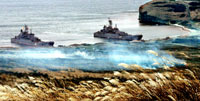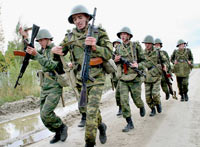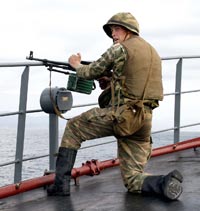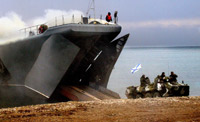| Tell a friend | Print version |
|---|
Under Flag of St. Andrew
 Marine is a distinct unified branch not only in Navy but Russian Armed Forces in whole. Its main mission is amphibious assault landing, but "black berets" is that force which secures our naval bases from the land. Organization of counter-landing defense needs proficiency of conducting battle at urban quarters, at area of piers, quays and harbor installations. Marines have always scarified enemy. But where did "black berets" get this fortitude and invincible will?
Marine is a distinct unified branch not only in Navy but Russian Armed Forces in whole. Its main mission is amphibious assault landing, but "black berets" is that force which secures our naval bases from the land. Organization of counter-landing defense needs proficiency of conducting battle at urban quarters, at area of piers, quays and harbor installations. Marines have always scarified enemy. But where did "black berets" get this fortitude and invincible will?
 Once upon a time, USSR Fleet Admiral Sergei Gorshkov who had recreated Marine after WW2 met with Airborne Forces Commander General of the Army Vasily Margelov. They talked about whose subordinates are better. Margelov said one trooper could fight against ten enemies. Gorshkov in return said one marine could only beat two… troopers. That's a joke, of course. However, our predecessors recreating Marine did not forget about its glorious combat traditions. "The victory is where we are" – that's a proverb about marines. And what makes a special aura around "black berets" is their adhesion to best traditions.
Once upon a time, USSR Fleet Admiral Sergei Gorshkov who had recreated Marine after WW2 met with Airborne Forces Commander General of the Army Vasily Margelov. They talked about whose subordinates are better. Margelov said one trooper could fight against ten enemies. Gorshkov in return said one marine could only beat two… troopers. That's a joke, of course. However, our predecessors recreating Marine did not forget about its glorious combat traditions. "The victory is where we are" – that's a proverb about marines. And what makes a special aura around "black berets" is their adhesion to best traditions.
 Coastal forces are among the principal components of Russian Navy. They are deployed at all fleets including Caspian Flotilla. They are special troops of the Navy having distinct structure and weapons; they are used as landing assaults and for defense of fleets' basing sites, critical coastal objects and coastline areas, destruction of enemy's surface ships, landing units, convoys within engagement zone, securing deployment of friendly forces and their return to home bases, screening basing sites.
Coastal forces are among the principal components of Russian Navy. They are deployed at all fleets including Caspian Flotilla. They are special troops of the Navy having distinct structure and weapons; they are used as landing assaults and for defense of fleets' basing sites, critical coastal objects and coastline areas, destruction of enemy's surface ships, landing units, convoys within engagement zone, securing deployment of friendly forces and their return to home bases, screening basing sites.
 Creation of Russian Marine is closely connected with the struggle of our country for access to sea and protection of sea borders during North War of 1700–1721. In November 1705 Admiral F.A. Golovin executing instructions of Peter the Great wrote a letter to Vice Admiral K.I. Kruis with an order to form the first regiment of naval soldiers. That day is customary to consider the Russian Marine's birth date. The main purpose of those naval soldiers was carrying out sea duty and boarding battles.
Creation of Russian Marine is closely connected with the struggle of our country for access to sea and protection of sea borders during North War of 1700–1721. In November 1705 Admiral F.A. Golovin executing instructions of Peter the Great wrote a letter to Vice Admiral K.I. Kruis with an order to form the first regiment of naval soldiers. That day is customary to consider the Russian Marine's birth date. The main purpose of those naval soldiers was carrying out sea duty and boarding battles.
 First baptism by fire was given to Marine in 1706 at Vyborg Gulf when boarding party of Capt Bakhtiyarov captured Swedish boat Espern. That team also distinguished itself during famous Gangut Battle in 1714.
Since that time Russian marines have taken part in almost all largest naval campaigns. Marine units have been landing on islands and continents to seize coastal forts or committing sabotage; being in boarding parties, they have been capturing enemy ships. Marines have been frequently used for reinforcements of land groupings. They had also approved themselves in Seven-year War, during siege of fortress Colberg and in Russian-Turkish wars at the end of XVIII century. That was a time when that Marine was born which showed itself during siege and seizure of Izmail Fortress.
First baptism by fire was given to Marine in 1706 at Vyborg Gulf when boarding party of Capt Bakhtiyarov captured Swedish boat Espern. That team also distinguished itself during famous Gangut Battle in 1714.
Since that time Russian marines have taken part in almost all largest naval campaigns. Marine units have been landing on islands and continents to seize coastal forts or committing sabotage; being in boarding parties, they have been capturing enemy ships. Marines have been frequently used for reinforcements of land groupings. They had also approved themselves in Seven-year War, during siege of fortress Colberg and in Russian-Turkish wars at the end of XVIII century. That was a time when that Marine was born which showed itself during siege and seizure of Izmail Fortress.
 One of the glorious pages in chronicles of Russian Marine was its participation in Mediterranean campaign of F.F. Ushakov in 1798–1800 when Russia waged in second coalition against France. As a result of brilliant landing operations, Ionian Islands were freed from the French; Corfu Fortress being considered unapproachable was captured by sea assault; central and southern Italy were freed, Naples and Rome were occupied.
One of the glorious pages in chronicles of Russian Marine was its participation in Mediterranean campaign of F.F. Ushakov in 1798–1800 when Russia waged in second coalition against France. As a result of brilliant landing operations, Ionian Islands were freed from the French; Corfu Fortress being considered unapproachable was captured by sea assault; central and southern Italy were freed, Naples and Rome were occupied.
Naval regiments established in 1803 (three at Baltic Fleet and one at Black Sea Fleet) also added a new chapter in the Russian Marine's history.
Formed in 1810, naval guard company – the only unit in Russian Navy's history constituting both ship's crew and infantry battalion – had been taking part in almost all wars of ÕIÕ-ÕÕ centuries, having multiplied heroic traditions of Marine.
 Marine was widely used during World War I. Huge number of sailors fought at land fronts of Civil War. Marine greatly evolved during Great Patriotic War; at different times 21 marine brigades, over 30 naval infantry brigades, tens of independent marine regiments and battalions fought then. The country highly appreciated military merits of Marine in the Great Patriotic War – 5 brigades and 2 battalions were awarded with honorary rank of Guard, 9 brigades and 6 battalions were awarded with medals and honorary names. Tens of thousands marines were rewarded with medals; over 150 were honored with sonorous title of Hero of the Soviet Union.
Marine was widely used during World War I. Huge number of sailors fought at land fronts of Civil War. Marine greatly evolved during Great Patriotic War; at different times 21 marine brigades, over 30 naval infantry brigades, tens of independent marine regiments and battalions fought then. The country highly appreciated military merits of Marine in the Great Patriotic War – 5 brigades and 2 battalions were awarded with honorary rank of Guard, 9 brigades and 6 battalions were awarded with medals and honorary names. Tens of thousands marines were rewarded with medals; over 150 were honored with sonorous title of Hero of the Soviet Union.
 In 1956 military authorities of the country made an erroneous decision to disband Marine units. However, missions of the Navy and development of weapons and tactics needed revival of Marine at radically new level. Experience of world powers proved that modern armed forces should have high-mobility components capable to perform combat tasks far from their bases having sufficient independence to conduct warfare. Possessing such forces it is possible to have military and political impact on any country. With this object in mind it was decided to establish forces in the Navy which would capable to perform distant cruises, prepared for engagement in extreme conditions and various climatic zones. Thus, early 60-ies the recreation of Marine started with the participation of Soviet Navy leaders. At that new stage Marine had passed the whole range of transformations and brilliantly completed variety of missions displaying heroism and the highest will to victory.
In 1956 military authorities of the country made an erroneous decision to disband Marine units. However, missions of the Navy and development of weapons and tactics needed revival of Marine at radically new level. Experience of world powers proved that modern armed forces should have high-mobility components capable to perform combat tasks far from their bases having sufficient independence to conduct warfare. Possessing such forces it is possible to have military and political impact on any country. With this object in mind it was decided to establish forces in the Navy which would capable to perform distant cruises, prepared for engagement in extreme conditions and various climatic zones. Thus, early 60-ies the recreation of Marine started with the participation of Soviet Navy leaders. At that new stage Marine had passed the whole range of transformations and brilliantly completed variety of missions displaying heroism and the highest will to victory.
 Second generation of Soviet Marine started its history like Russian Imperial Marine – at Baltic Fleet, where Marine Guard regiment was formed in 1963. At the same year a marine regiment was established at Pacific Fleet, in 1966 – at Northern Fleet and in 1967 – at Black Sea Fleet.
Second generation of Soviet Marine started its history like Russian Imperial Marine – at Baltic Fleet, where Marine Guard regiment was formed in 1963. At the same year a marine regiment was established at Pacific Fleet, in 1966 – at Northern Fleet and in 1967 – at Black Sea Fleet.
In 1967 a marine division was formed at Pacific Fleet which had become the first Navy's Marine formation. "Black berets" have multiply been demonstrating its high combat qualification, courage and military skills at numerous landing exercises and maneuvers Vltava-66, Dnepr-67, Dvina-70, Yug-71, Ocean, Zapad-81, Yug-86 etc.
Marines participated in local conflicts during cold war as well, for instance, in Angola, Yemen and other distant sites worldwide.
 At post-Soviet times "black berets" took part in two Chechnya campaigns. Weapons did much justice to themselves then. So did people. Over twenty marines were honored with title of Hero of Russia for bravery and heroism; more than 5,000 "black berets" were awarded with medals.
At post-Soviet times "black berets" took part in two Chechnya campaigns. Weapons did much justice to themselves then. So did people. Over twenty marines were honored with title of Hero of Russia for bravery and heroism; more than 5,000 "black berets" were awarded with medals.
Presently, marines are actively engaged in combat training; they participate in various exercises as well. "Black berets" are successfully performing combat task on protecting international navigation from pirates near Horn of Africa.
 All abovementioned demonstrates that current Marine is one of the battleworthiest branches in Russian Navy. Modern Marine is mobile, well-equipped and prepared force securing Russia's national interests at all ocean theatres of operations. It is armed with newest weapon, large landing craft, air cushion ships and armor vehicles.
All abovementioned demonstrates that current Marine is one of the battleworthiest branches in Russian Navy. Modern Marine is mobile, well-equipped and prepared force securing Russia's national interests at all ocean theatres of operations. It is armed with newest weapon, large landing craft, air cushion ships and armor vehicles.
We would like to wish "black berets" always calm sea under ships and hospitable coast ahead!
Source: , Author: Andrei GAVRILENKO. Photos by Vitaly ANKOV and Evgeny USTINOV. 25.11.09
Translation: RusNavy.com



